It’s 3 PM, and the recent, vivid equatorial solar remains to be excessive in its descending arch to the western horizon. The wind is calm, and the ocean is clean as our rigid-bottom inflatable (aka RBI or panga) driver, Alex, idles the brief distance from the Galapagos Aggressor II (GAII) to our entry level, a cove close to Punta Vicente Roca, on the northeast nook of Isla Isabela.
Getting ready for the Dive at Punta Vicente Roca
Armed in 7mm of black neoprene from head to toe, the 5 divers in our panga are starting to sweat uncomfortably below the blazing solar. Our divemaster Richard can be utterly coated in black rubber and senses our discomfort.
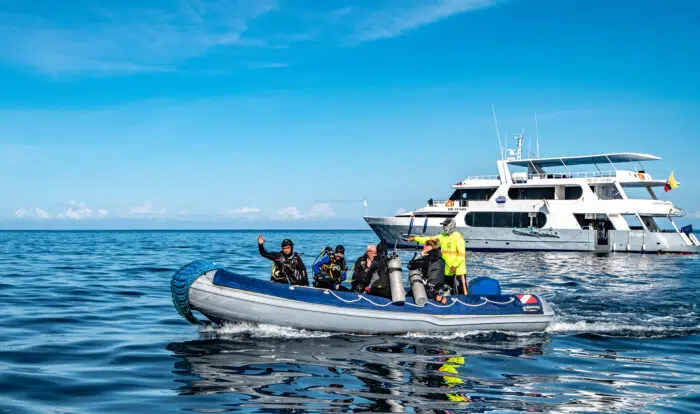
“Divers’ prepare!” he hurries, and we don our masks, insert our regulator mouthpieces, and test our picture kits one final time.
The Local weather Paradox of the Galapagos Islands
It’s an oxymoron to use thick rubber fits for a dive at latitude 0.0536 south—one-half-of-a-degree south of the equator! However we’re diving into the Galapagos Islands, a local weather paradox as a consequence of geography. They straddle the earth’s latitudinal centerline within the japanese Pacific Ocean, 1000 km from South America.
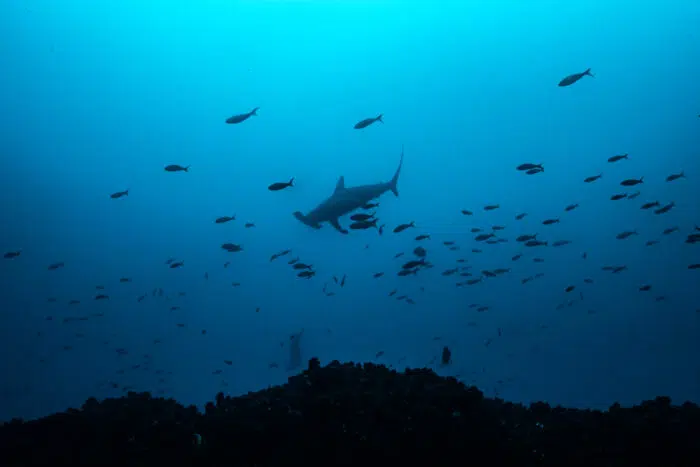
Logically, it’s truthful to purpose that waters bathing the Galapagos archipelago needs to be bathtub-warm. But, as a consequence of its distinctive international placement, the Galapagos Islands are washed by three main and 4 minor oceanic currents, which at occasions converge, diverge, combine, and layer, leading to steady water temperature contradictions. This happens all through the islands, which is why we have been ensconced in protecting attire at Punta Vicente Roca.
Coming into the Waters of Galapagos: A Diver’s Perspective
“On the depend of three!” Richard alerts, and, in unison, we roll right into a heat, murky brine on the finish of his depend.
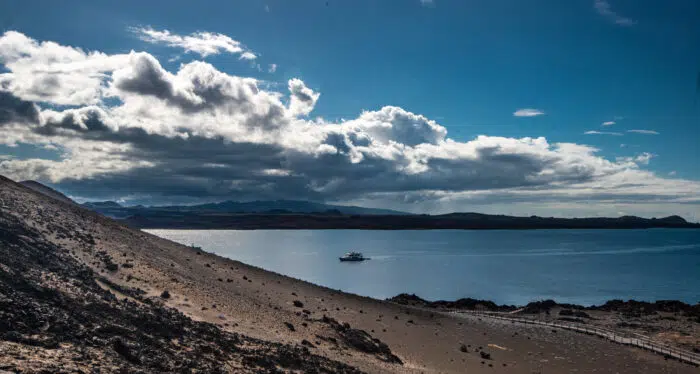
The oxymoron continues; on the floor, this web site has little present. Seawater swimming pools across the cove and warms significantly within the tropical solar. The result’s an area micro-bloom of plankton within the nutrient-rich floor water, contrasting with the cool water beneath an ever-present thermocline by as a lot as 12C.
Collectively, we settle, piercing the murky soup at 15m to a deep inexperienced, very clear, ethereal world. On the shimmering transition between heat and funky, the temperature immediately drops from 26C to 20C, with visibility going from one to +33m!
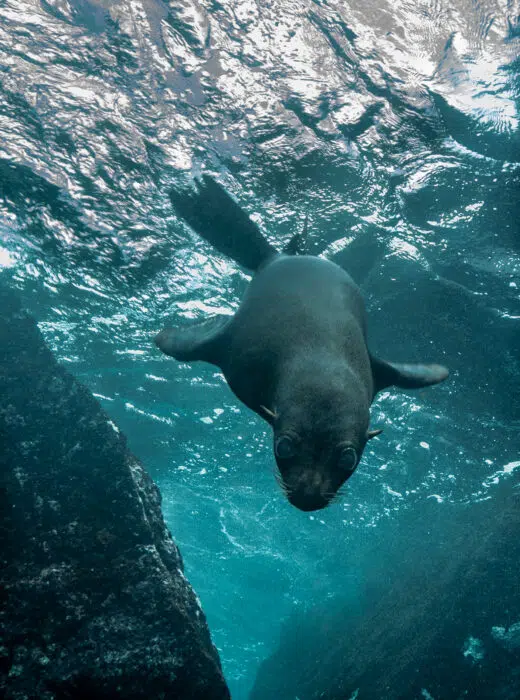
Encountering Galapagos Sea Lions and Mola Mola
We glide the slope downward, adjusting buoyancy, previous spectacularly coloured tapestries of sea followers, towards the white sandy backside at practically 35m. Within the gloaming, a pair of juvenile Galapagos sea lions, ubiquitous on most dives within the Galapagos, rocket previous us from behind. Then, taking pictures upward, they barrel-roll via our exhaust trails to the floor, their playful drive-by full. Now, three meters above the sandy ground, the water temperature has cooled to 17C, difficult our 7mm’s, within the otherworldly twilight.
Abruptly, Richard bangs his tank with a steel clapper, snapping me from whiney ideas concerning the chilly. He indicators our group to look towards the deep. Within the distance, a pair of Mola Mola materialize, sliding slowly towards our gob-smacked band of observers. It’s a super-rare look, particularly after Richard had proclaimed earlier than the dive that we’d seemingly not see Mola Mola as a result of it was “too heat.”
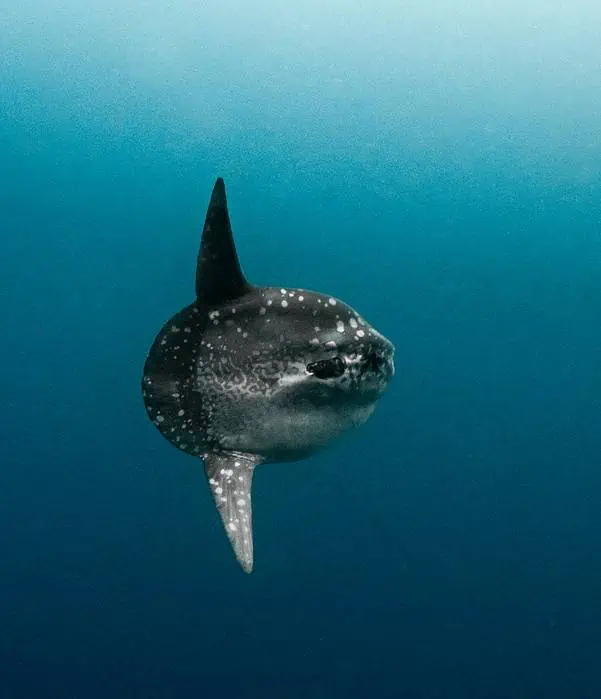
Now not excited about the coolness, I test my digital camera, maintain my bubble exhaust, and push with a single thrust towards the lead fish, making an attempt to look small and innocuous. Whereas not a full-sized grownup, this fish spans no less than two meters between fin ideas. I glide nearer, and the mola mola follows me with a big, curious eye. I’m, apparently, not a risk but additionally nothing of curiosity. The Mola Mola turns to the deep and slowly disappears with a delicate flutter of its large dorsal and ventral fins. However solely after I used to be capable of click on a single picture!
I flip again to the group the place the wall meets the sandy airplane and watch my fellow divers have fun the uber-exceptional sighting with excited head bobs and fist pumps. Regardless of Richard’s prediction, or possibly due to Richard’s prediction, we had an in depth encounter with an animal I’d by no means earlier than witnessed in 40 years of diving!
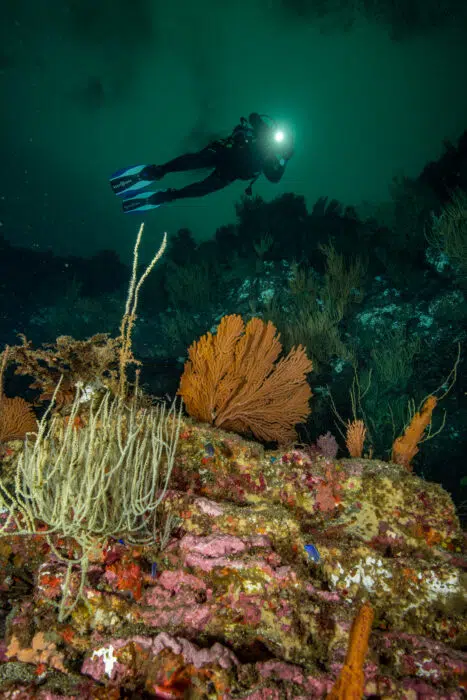
A Nearer Take a look at Galapagos Marine Life
Time is brief, and we transfer to a valley of sentimental corals past the sandy airplane in the hunt for elusive seahorses. Our good juju continues; Richard and one in all our divers discover a cleverly camouflaged seahorse among the many softies.
Pleasure abounds within the now refreshingly cool deep sea as we shoot our photographs and seek for different exotics earlier than our dive computer systems tick towards finality.
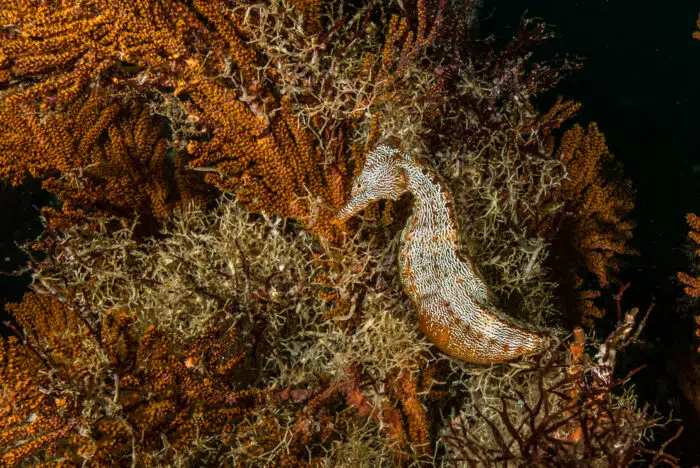
The Distinctive Fauna of the Galapagos Islands
So it could actually go within the Galapagos Islands. A carnival of animal oddities and rarities, each on land and sea, which attracts divers from all over the world. So distinctive is the fauna, that one may virtually envision an early, Twentieth-century carney barker loquaciously extolling the exotica.
“Girls and Gents…Step proper Up! Come inside and be incredulous! Feast your eyes on a one-ton fish with no fins and no tail! Or marvel on the education sharks whose heads are formed like a coat hanger! Not impressed? How a few tortoise as massive as a clown automotive or a lizard that eats within the sea?”
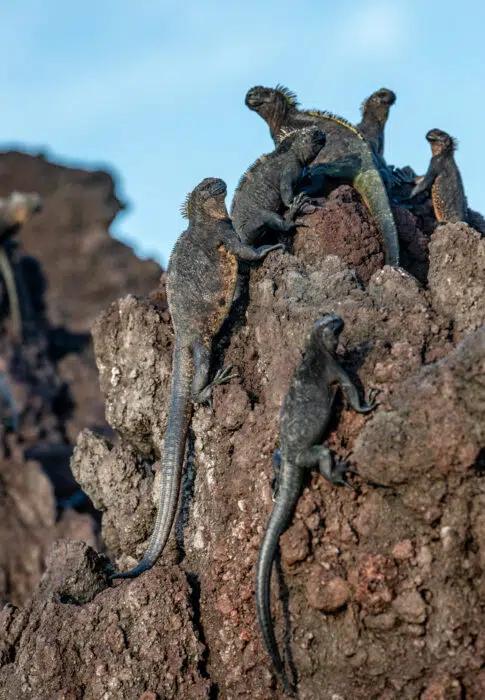
Certainly, the Galapagos Islands stands out as the “biggest present on earth.” For the reason that fall of 1825, when Charles Darwin, aboard the British brig HMS Beagle, set foot within the Galapagos, explorers have acclaimed the wonders of those magnificent islands. Having been referred to as “a singular dwelling museum and a showcase of evolution” and “a melting pot of marine species” by visiting naturalists, the Galapagos is a bucket record vacation spot for a lot of. Really, this has introduced me again to those exceptional islands for the fifth time within the final 15 years.
The Geographic and Geological Wonders of the Galapagos
The Galapagos archipelago contains 127 islands, islets, and rocks set between latitudes 1.40 levels North and 1.36 levels South. Volcanic in origin, the islands are comparatively younger geologically, just some 5 million years previous, and, within the case of Isla Isabela and Isla Fernandina, are nonetheless actively forming. Certainly, because the GAII steamed towards Darwin Island on the second night of our voyage, Wolf Volcano on Isabela was seen spewing smoke, ash, and lava on its northern flank.
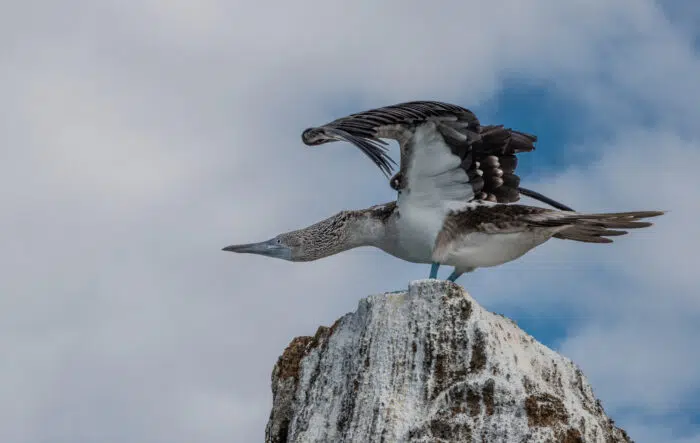
The geographic location, isolation, and confluence of ocean currents take the Galapagos’ metaphorical “petri dish of black volcanic rock,” ensuing within the speciation of 14 totally different land animals discovered nowhere else on this planet. These animals embrace the Galapagos penguin, the Galapagos tortoise, the marine iguana, the blue-footed booby, the Galapagos flightless cormorant, and the Galapagos hawk.
Oceanwise, speciation just isn’t fairly as distinctive. Many resident species, such because the scalloped hammerhead shark, Galapagos shark, eagle ray, and inexperienced sea turtle, are discovered elsewhere as ocean currents have introduced circum-tropical and circum-temperate marine life to the islands extra simply. As such, the one obvious endemic species I may discover in analysis is the inexperienced sea urchin, which was splendidly considerable at Roca Blanca.

The break up character of water temperatures, distinctive land creatures, and side-show-like marine animals, all on the identical voyage, invitations an action-packed week for divers and underwater photographers. The place else can a diver discover tropical long-nose butterflyfish at some point and temperate-loving Mola Mola on the following?
Diving within the Northern Galapagos: Wolf and Darwin Islands
The northern islands of Wolf and Darwin have been our first main vacation spot on our week’s voyage on the GAII. Situated above the equator and washed by a comparatively heat equatorial present (heat sufficient to help stony corals), these islands are famend for education scalloped hammerhead sharks, eagle rays, and the uncommon whale shark when currents are robust and unidirectional.
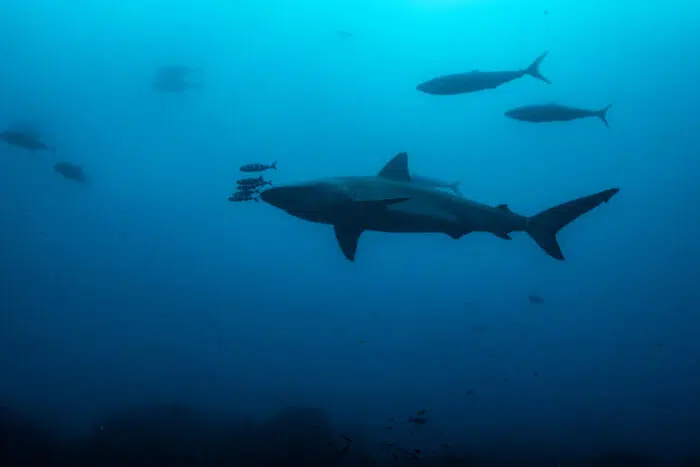
Oddly, throughout our go to, which coincided with the again of the complete moon, when tides ought to have been the strongest, the present(s) appeared confused, typically pushing a method on the floor and the wrong way down deep. In consequence, the education sharks have been a no-show. Nevertheless, throughout our dives, we witnessed many single shark drive-bys and completely explored the reef surrounding Darwin’s Columns (previously Darwin’s Arch) and Landslide Reef at Wolf.
The delicate, conflicted currents additionally allowed us to shoot different areas (the Cave at Wolf Island) and lesser-acknowledged “side-show circus performers” on the reefs, together with curious faculties of barber fish and sedate inexperienced sea turtles when our focus would have been in any other case directed (actually and figuratively) to the sharks.
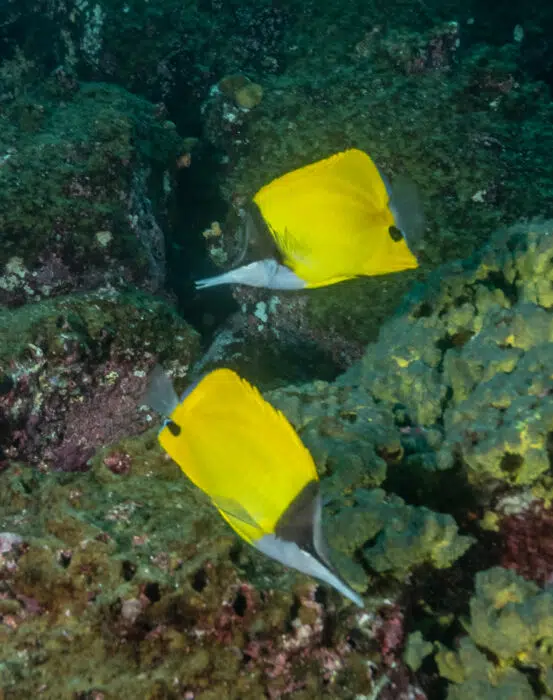
Southern Galapagos: The Marine Iguanas of Isla Fernandina
Whereas the Galapagos’ circus-center-ring performers have been on hiatus within the north, the Islands’ side-show performers of the south picked up the slack. At Cape Douglas on Isla Fernandina, the marine iguanas have been sun-fueled early. They entered the water at 10 AM to feed, giving our divers on the GAII a singular alternative to look at one more oxymoron of the archipelago: the lizard that eats within the sea.
By the a whole bunch, if not hundreds, the charcoal-colored reptiles perch on the again volcanic rocks, if not one another, at Cape Douglas close to the ocean’s edge. They heat themselves sufficiently there earlier than venturing into the cool Pacific to feed on marine algae briefly. Our carnival barker would have been happy, as we marveled incredulously at this behavioral oddity.
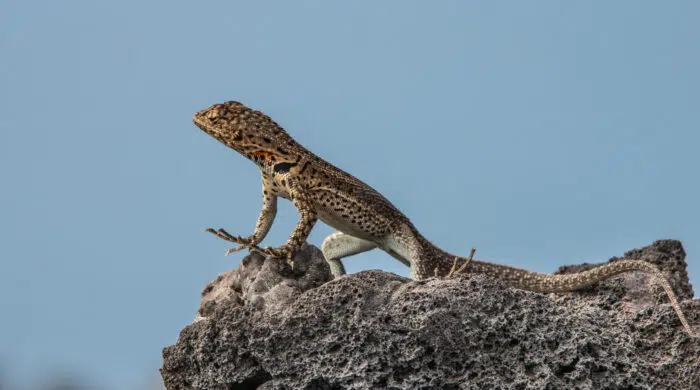
Capturing the Playful Galapagos Sea Lions
Additional alongside our voyage within the south, we encountered the omnipresent Galapagos Sea Lions, whose playful antics drive a photographer mad. Like Whirling Dervish, the endemic pinnipeds’ fluidity challenged my taking pictures on each stage. Whereas the juveniles are probably the most curious, younger females typically take part, ultimately eliciting a response from the harem’s dominant male.
As if to say, “Alright, sufficient is sufficient!” the massive male will intervene between the divers and the females, blowing a “warning” exhaust path of bubbles from his nostrils.
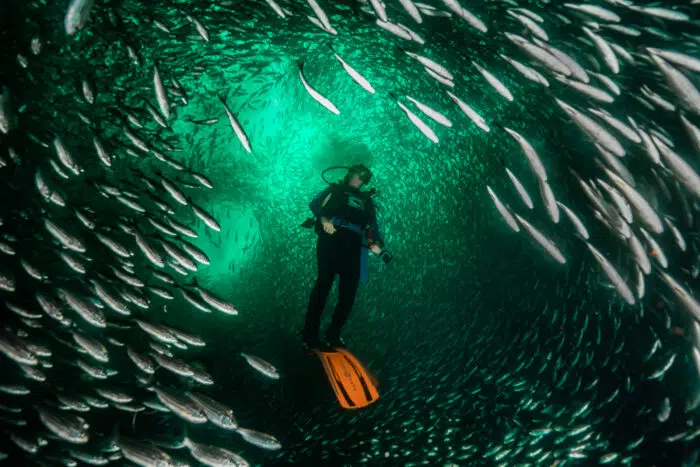
One afternoon at a comparatively innocuous rock named Cowley, we encountered “the mom of all” fish faculties. The positioning is known for its large faculty of black-striped Salema. Hundreds, if not hundreds of thousands, of Salema shift form endlessly from the floor to the seafloor at Cowley. If it weren’t for the torch of our divemaster or the glint of a strobe flash from my diving mates, I certainly would have misplaced my means because the Salema turned day to nighttime at 20m.
Land Safaris: Discovering Extra of Galapagos’ Endemic Species
No journey to the Galapagos will be thought-about full with no land safari or two to look at extra of Charles Darwin’s pure choice superstars. The GAII gave us two land excursions plus a shoreline cruise to search out extra animals endemic to the Galapagos. At Isla Bartolome, we climb the height (made well-known within the Russell Crowe movie Grasp and Commander: The Far Aspect Of The World) the place a Galapagos hawk, perched on a excessive rock, and a lava lizard, cooling its toes on a low rock, showcased an impressive overlook of the GAII within the passage beneath. At Pinnacle Rock, we discovered a blue-footed booby, a Galapagos penguin, and the Galapagos flightless cormorant, permitting picture seize of but extra Galapagos “A-listers.”
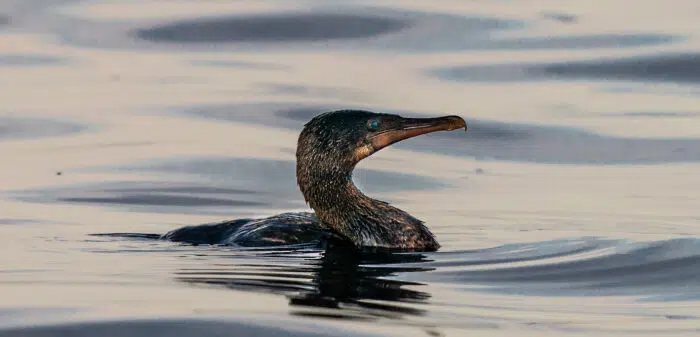
The Grand Finale: Galapagos Large Tortoises
On our final afternoon, after the attentive GAII crew had washed our dive kits, we traveled upcountry to a farm on Isla Santa Cruz, the place we noticed the ultimate act of the circus: the world’s largest tortoise within the wild. Our imaginary carnival barker wouldn’t have been exaggerating, for the estimated 80-year-old tortoise would have rivaled the dimensions of a small clown automotive!
As I look again on the locations I’ve explored through the years, I’m not stunned that the Galapagos has captured my time and curiosity a number of occasions. The Galapagos Islands are a circus of the odd, ridiculous, and grandiose. And just like the circus with requisite sideshows, it attracts the curious like a moth to a flame. For this reason I’m already planning my sixth journey again to see the best present on earth.
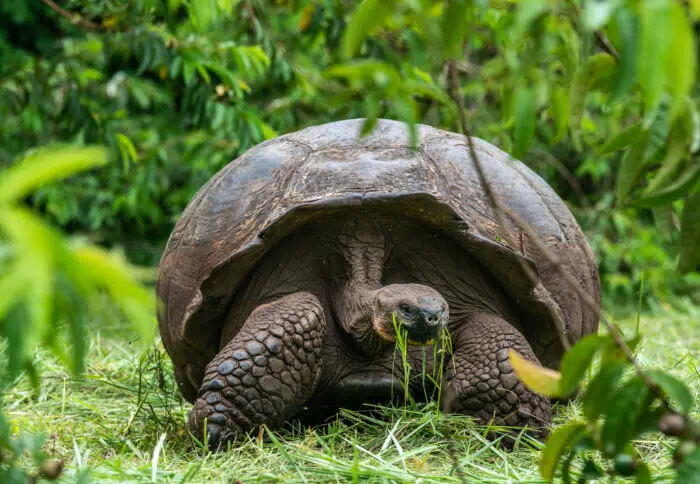
Different Useful Data
Location
When to go
The Galapagos Islands will be visited year-round because the change between summer time and winter months is minimal on the equator. Verify along with your Aggressor journey planner whereas assessing one of the best time to see sure species with a better diploma of regularity primarily based on the month of the yr.
Getting there
All flights to the Galapagos Islands originate from Quito or Guayaquil in Ecuador. Plan on arriving in Ecuador the day earlier than journey departure. Direct flights to the Islands from both Quito or Guayaquil can be found from two airways a number of occasions every day.
Selecting an journey itinerary
Go to www.aggressor.com
Different data
The journey planners at Aggressor will apprise you of the newest journey necessities/restrictions primarily based on probably the most present COVID-19 circumstances.
Article By Mark B. Hatter – Mark is a long-time out of doors photojournalist specializing in scuba diving pictures and fly fishing essays and have articles. Over time Mark’s photographs, cowl photographs, and tales, from each continent, have appeared in over two dozen totally different publication titles, together with magazines, books, and business promoting.
This can be a sponsored publish – for extra data please see our disclosure coverage.

